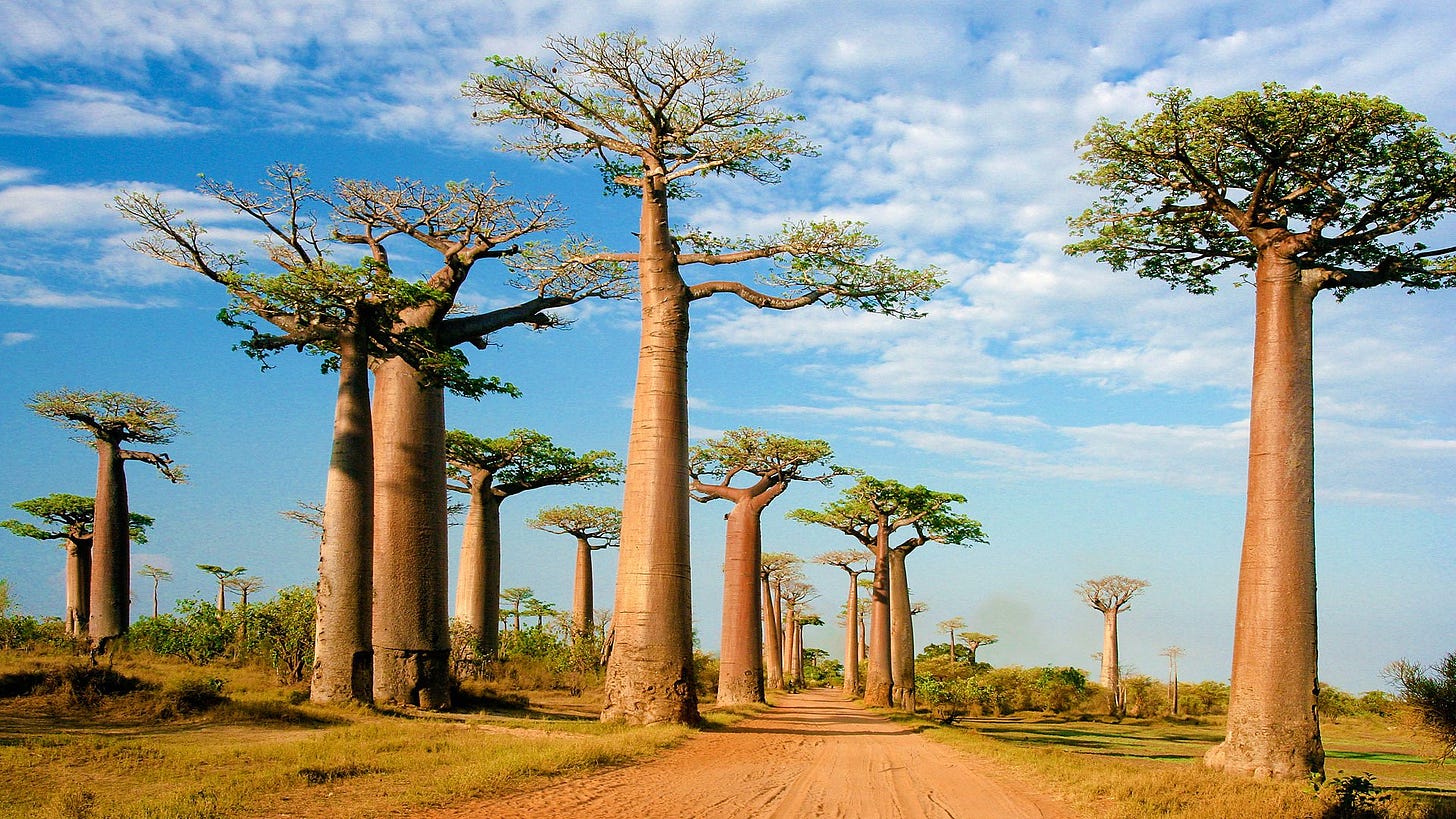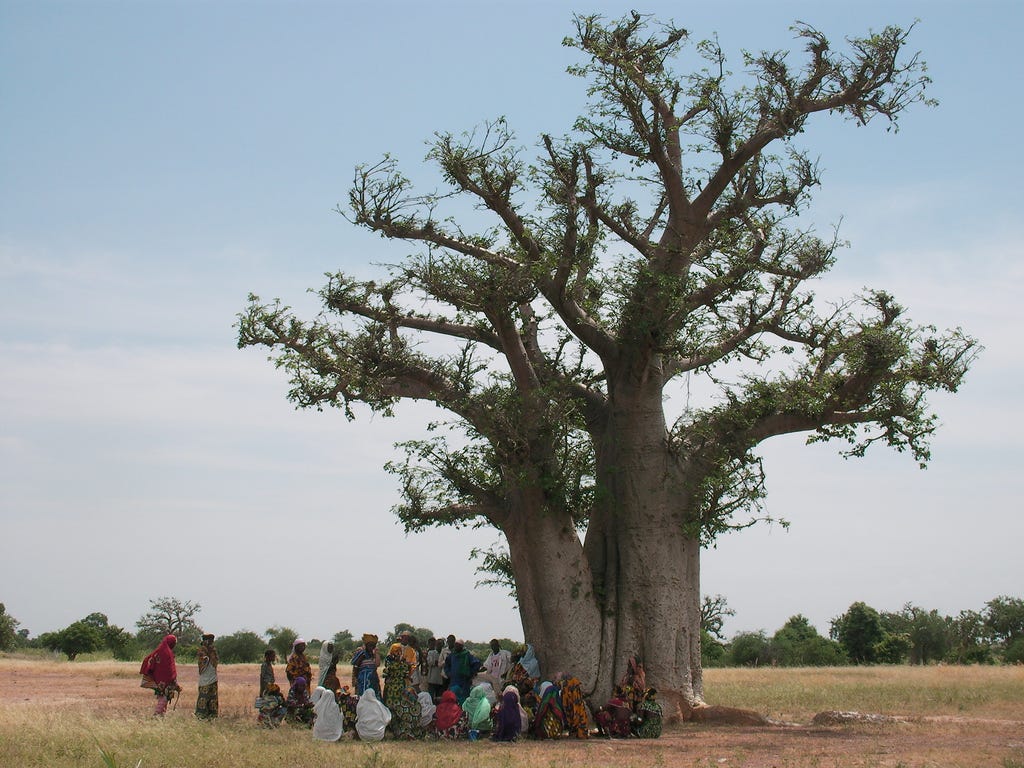Baobab: The Tree Of Life
Acknowledging one of the great natural marvels of Africa
I don’t want to assume all my readers are religious or believe in a god, spirituality or any form of higher power. Of course for Africans, spirituality is a cornerstone and there isn’t a tribe on the continent that isn’t deeply rooted in some form of it.
As such, for the sake of this conversation, I will assume you at least have a passing interest in the possibility that humanity is connected to higher powers. Something beyond our immediate comprehension. Thus I ask this question; Do you believe in the tree of life? If you do, where do you believe it would be?
This week’s voyage will be into the mysticism of nature in Alkebulan. The belief that the descendants of the tree of life still grows from the soil in the African continent.
Amidst the vast African savannah stands a towering sentinel, the baobab tree, a symbol of life, resilience, and sustenance in the heart of the continent. Revered in various African societies as the "Tree of Life," the baobab tree has not only cultural significance but also medicinal and nutritional value.
The Baobab Tree: A Botanical Marvel
Adansonia, the genus to which the baobab belongs, comprises nine species, six of which are native to Madagascar, two to mainland Africa, and one to Australia. The African baobab, Adansonia digitata, is the most renowned and often referred to simply as the "baobab."
The baobab's distinctive appearance is a testament to its unique adaptability and longevity. With its massive, barrel-like trunk, gnarled branches, and peculiar, upside-down appearance during the dry season, the baobab tree is a botanical marvel. Some individuals are believed to have lived for over a thousand years, making them among the oldest living organisms on Earth.
Cultural Significance: The "Tree of Life"
The baobab tree is revered as a symbol of life, community, and tradition in Africa, and its cultural significance is deeply embedded in the stories, beliefs, and practices of various African societies.
The baobab tree is not just a part of African landscapes; it is also woven into the fabric of African mythology. Many African cultures have myths and legends that revolve around the baobab tree. In some stories, it is said that the gods planted the baobab tree upside down as a punishment for its arrogance, explaining its peculiar appearance during the dry season. These myths reinforce the idea of humility and respect for nature, teaching important lessons about the consequences of pride.
Gathering Place and Shelter
The baobab tree also has practical significance to communities. It often serves as a gathering place, where people come together to discuss important matters, share stories, and seek shade from the scorching African sun. Its colossal trunk and canopy provide shelter and comfort, fostering a sense of unity and belonging. Under the cooling shade of the baobab, traditions are passed down through generations, and communal bonds are strengthened.
Rituals and Ceremonies
In some African societies, the baobab tree is associated with rituals and ceremonies, and is where important rites of passage, such as initiation ceremonies and marriages, are conducted. These rituals further cement its role as a symbol of life's milestones, as the baobab witnesses and blesses the significant moments in the lives of community members.
Medicinal and Nutritional Value
Beyond its cultural symbolism, the baobab tree offers a treasure trove of medicinal and nutritional benefits. Its various parts, from leaves and fruits to bark and seeds, are utilised for a wide range of purposes.
The baobab fruit is often referred to as the "superfruit" due to its exceptional nutritional profile. It’s rich in vitamin C, calcium, potassium, and antioxidants. The fruit pulp is used to make a tangy and nutrient-dense powder that can be added to foods and beverages, providing a boost of vitamins and minerals. This nutritional powerhouse not only supports the health of those who consume it but also contributes to food security in regions where the baobab thrives.
In traditional African medicine, various parts of the baobab tree are used to treat a multitude of ailments. The bark, for example, is believed to have antimicrobial properties and is used to treat fevers, diarrhea, and digestive issues.
Baobab leaves are used to make a medicinal tea that is thought to alleviate a range of health problems, including respiratory issues and skin conditions. The baobab's role as a source of natural remedies underscores its importance in traditional healthcare systems.
Water Storage
One of the baobab tree's remarkable adaptations is its ability to store water in its trunk during the wet season. This reservoir of water can be tapped during droughts, providing a lifeline for both humans and wildlife during times of scarcity. This unique ability to store water adds to the tree's reputation as a provider of life in arid and semi-arid regions.
Conservation Efforts and Challenges
While the baobab tree is celebrated for its significance and utility, it faces several challenges, including habitat loss, climate change, and deforestation. Conservation efforts are crucial to ensure the preservation of these ancient giants and the ecosystems they support.
The expansion of agriculture, infrastructure development, and urbanization have led to the loss of baobab habitats in some regions. As human populations grow and demand for land increases, preserving the natural landscapes that baobabs call home becomes increasingly challenging.
Climate change poses a significant threat to baobab populations. Altered rainfall patterns, increased temperatures, and more frequent droughts can stress these trees, making them more susceptible to diseases and pests. Climate change mitigation and adaptation strategies are essential to protect baobab ecosystems.
The baobab's wood, known for its resilience and durability, has been harvested for various purposes, including building materials and carvings. Unsustainable logging practices can lead to deforestation and a decline in baobab populations. This is a major issue.
A species of tree where some have lived for over a thousands years is incredible. It’s literally seen everything. Seen empires rise and fall. Eras of life our human eyes will never see or comprehend. It’s important that such natural marvels of Africa are common knowledge amongst the community so that we are inspired to do what we can to preserve them as much as the Europeans ferociously protect their wonders.
PAY ATTENTION






Am convince 👏👏👏💯💯💯
Before coming home to Alkebulan, I was awestruck and smitten with with these trees. I always believed there was something special magical and other wordly about them. So, imagine my first encounter!!! The life radiating from them... It is easy to accept the mowana, as it is called in Botswana, as The Tree of Life. I even have portions, the seeds, of its fruits,in a jar on a shelf. I enjoyed a few today.